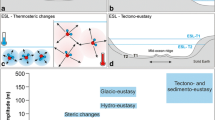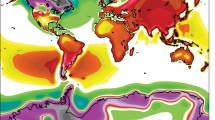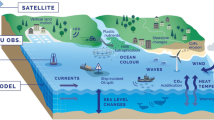Abstract
The accuracy of ocean tide loading (OTL) displacement values has long been assumed to be dominated by errors in the ocean tide models used, with errors due to the convolution scheme used considered very small (2–5%). However, this paper shows that much larger convolution errors can arise at sites within approximately 150 km of the coastline, depending on the method used to refine the discrete regularly spaced grid cells of the ocean tide model to better fit the coastline closest to the site of interest. If the local water mass redistribution approach is implemented, as used in the OLFG/OLMPP software recommended in the IERS 2003 conventions, OTL height displacement errors of up to around 20% can arise, depending on the ocean tide model used. Bilinear interpolation only, as used in the SPOTL and CARGA softwares for example, is shown from extensive global and regional comparisons of OTL displacement values derived from the different methods and softwares to be more appropriate. This is verified using GPS observations. The coastal refinement approach used in the OLFG/OLMPP software was therefore changed in August 2007 to use bilinear interpolation only. It is shown that with this change, OTL displacement values computed using OLFG/OLMPP, SPOTL and CARGA invariably agree to the millimetre level for coastal sites, and better than 0.2 mm for sites more than about 150 km inland.
Similar content being viewed by others
References
Agnew DC (1997) NLOADF: A program for computing ocean-tide loading. J Geophys Res 102(B3): 5109–5110
Allinson CR, Clarke PJ, Edwards SJ, King MA, Baker TF, Cruddace PR (2004) Stability of direct GPS estimates of ocean tide loading. Geophys Res Lett 31(15). doi:10.1029/2004GL020588
Baker TF, Bos MS (2003) Validating Earth and ocean tide models using tidal gravity measurements. Geophys J Int 152(2): 468–485
Blewitt G (2003) Self-consistency in reference frames, geocenter definition, and surface loading of the solid Earth. J Geophys Res 108(B2): 2103 doi:10.1029/2002JB002082
Bos MS, Baker TF (2005) An estimate of the errors in gravity ocean tide loading computations. J Geod 79(1–3): 50–63
Bos MS, Baker TF, Røthing K, Plag H-P (2002) Testing ocean tide models in the Nordic seas with tidal gravity observations. Geophys J Int 150(3): 687–694
Boy J-P, Llubes M, Hinderer J, Florsch N (2003) A comparison of tidal ocean loading models using superconducting gravimeter data. J Geophys Res 108(B4):2193. doi:10.1029/2002JB002050
Dow JM, Neilan RE, Gendt G (2005) The International GPS Service: Celebrating the 10th anniversary and looking to the next decade. Advances in Space Research 36: 320–326
Eanes RJ, Bettadpur S (1996) The CSR3.0 Global Ocean Tide Model: Diurnal and Semi-Diurnal Ocean Tides from TOPEX/POSEIDON Altimetry. CSR-TM-96–05 The University of Texas Center for Space Research
Egbert GD, Bennett AF, Foreman MGG (1994) TOPEX/POSEIDON tides estimated using a global inverse model. J Geophys Res 99(C12): 24821–24852
Egbert GD, Erofeeva SY (2002) Efficient inverse modeling of barotropic ocean tides. J Atm Oceano Tech 19(2): 183–204
Farrell WE (1972) Deformation of the Earth by surface loads. Rev Geophys Space Phys 10(3): 761–797
Francis O, Mazzega P (1990) Global charts of ocean tide loading effects. J Geophys Res 95(C7): 11411–11424
Hendershott MC, Munk W (1970) Tides. Ann Rev Fluid Mech 2: 205–224
King M (2006) Kinematic and static GPS techniques for estimating tidal displacements with application to Antarctica. J Geodyn 41(1–3): 77–86
King MA, Penna NT, Clarke PJ, King EC (2005) Validation of ocean tidemodels around Antarctica using onshoreGPS and gravity data. J Geophys Res 110(B8):B08401. doi:10.1029/2004JB003390
King MA, Watson CW, Penna NT, Clarke PJ (2008) Subdaily signals in GPS observations and their effect at semiannual and annual periods. Geophys Res Lett 35:L03302. doi:10.1029/2007GL032252
Le Provost C, Genco ML, Lyard F, Vincent P, Canceil P (1994) Spectroscopy of the world ocean tides from a finite-element hydrodynamic model. J Geophys Res 99(C12): 24777–24797
Lefévre F, Lyard FH, Le Provost C, Schrama EJO (2002) FES99: A global tide finite element solutions assimilating tide gauge and altimetric information. J Atmos Ocean Technol 19(9): 1345–1356
Longman IM (1962) A Green’s function for determining the deformation of the Earth under surface mass loads, 1. Theory. J Geophys Res 67(2): 845–850
Longman IM (1963) A Green’s function for determining the deformation of the Earth under surface mass loads, 2. Computation and Numerical Results. J Geophys Res 68(2): 485–496
Lyard F, Lefévre F, Letellier T, Francis O (2006) Modelling the global ocean tides: Modern insights from FES2004. Ocean Dynam 56(5–6): 394–415
Matsumoto K, Takanezawa T, Ooe M (2000) Ocean tide models developed by assimilating TOPEX/POSEIDON altimeter data into hydrodynamical model: A global model and a regional model around Japan. J Oceanogr 56: 567–581
Matsumoto K, Sato T, Takanezawa T, Ooe M (2001) GOTIC2: A program for computation of oceanic tidal loading effect. J Geod Soc Japan 47: 243–248
McCarthy DD, Petit G (2004) IERS Conventions 2003. IERS Technical Note 32.
Melachroinos SA, Biancale R, Llubes M, Perosanz F, Lyard F, Vergnolle M, Bouin M-N, Masson F, Nicolas J, Morel L, Durand S (2007) Ocean tide loading (OTL) displacements from global and local grids: comparisons to GPS estimates over the shelf of Brittany, France. J Geod. doi:10.1007/s00190-007-0185-6
Penna NT, King MA, Stewart MP (2007) GPS height time series: Short-period origins of spurious long-period signals. J Geophys Res 112(B02402). doi:10.1029/2005JB004047
Petrov L, Ma CP (2003) Study of harmonic site position variations determined by very long baseline interferometry. J Geophys Res 108(B4):2190. doi:10.1029/2002JB001801
Press WH, Teukolsky SA, Vetterling WT, Flannery BP (1992) Numerical recipes in Fortran 77: the art of scientific computing. 2nd edn Cambridge University Press
Ray RD (1999) A global ocean tide model from TOPEX/POSEIDON altimetry: GOT99.2. NASA Tech Memo TM-209478, 58 pp
Scargle JD (1982) Studies in astronomical time series analysis. II. Statistical aspects of spectral analysis of unevenly spaced data. Astrophysical J 263: 835–853
Scherneck H-G (1991) A parametrized solid earth tide model and ocean tide loading effects for global geodetic base-line measurements. Geophys J Int 106(3): 677–694
Scherneck H-G (1993) Ocean tide loading: Propagation of errors from the ocean tide into loading coefficients. Manuscr Geod 18: 59–71
Schwiderski EW (1980) On charting global ocean tides. Rev Geophys Space Phys 18(1): 243–268
Shum CK, Woodworth PL, Andersen OB, Egbert GD, Francis O, King C, Klosko SM, Le Provost C, Li X, Molines JM, Parke ME, Ray RD, Schlax ML, Stammer D, Tierney CC, Vincent P, Wunch CI (1997) Accuracy assessment of recent ocean tide models. J Geophys Res 102(C11): 25173–25194
Thomas ID, King MA, Clarke PJ (2007) A comparison of GPS, VLBI and model ocean tide loading displacements. J Geod 81:359–368. doi:10.1007/s00190-006-0118-9
Urschl C, Dach R, Hugentobler U, Schaer S, Beutler G (2005) Validating ocean tide loading models using GPS. J Geod 78: 616–625
Wessel P, Smith WHF (1998) New, improved versions of the Generic Mapping Tools released. Eos Trans AGU 79(47): 579
Author information
Authors and Affiliations
Corresponding author
Rights and permissions
About this article
Cite this article
Penna, N.T., Bos, M.S., Baker, T.F. et al. Assessing the accuracy of predicted ocean tide loading displacement values. J Geod 82, 893–907 (2008). https://doi.org/10.1007/s00190-008-0220-2
Received:
Accepted:
Published:
Issue Date:
DOI: https://doi.org/10.1007/s00190-008-0220-2




